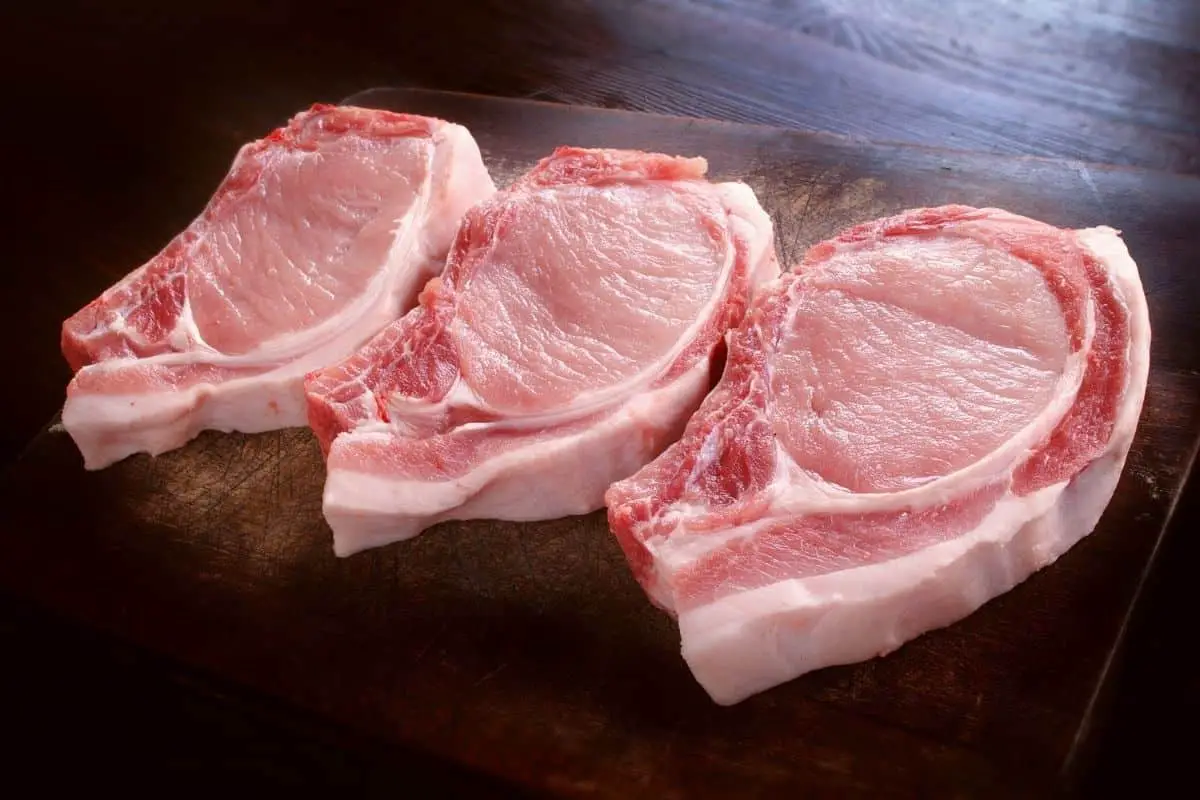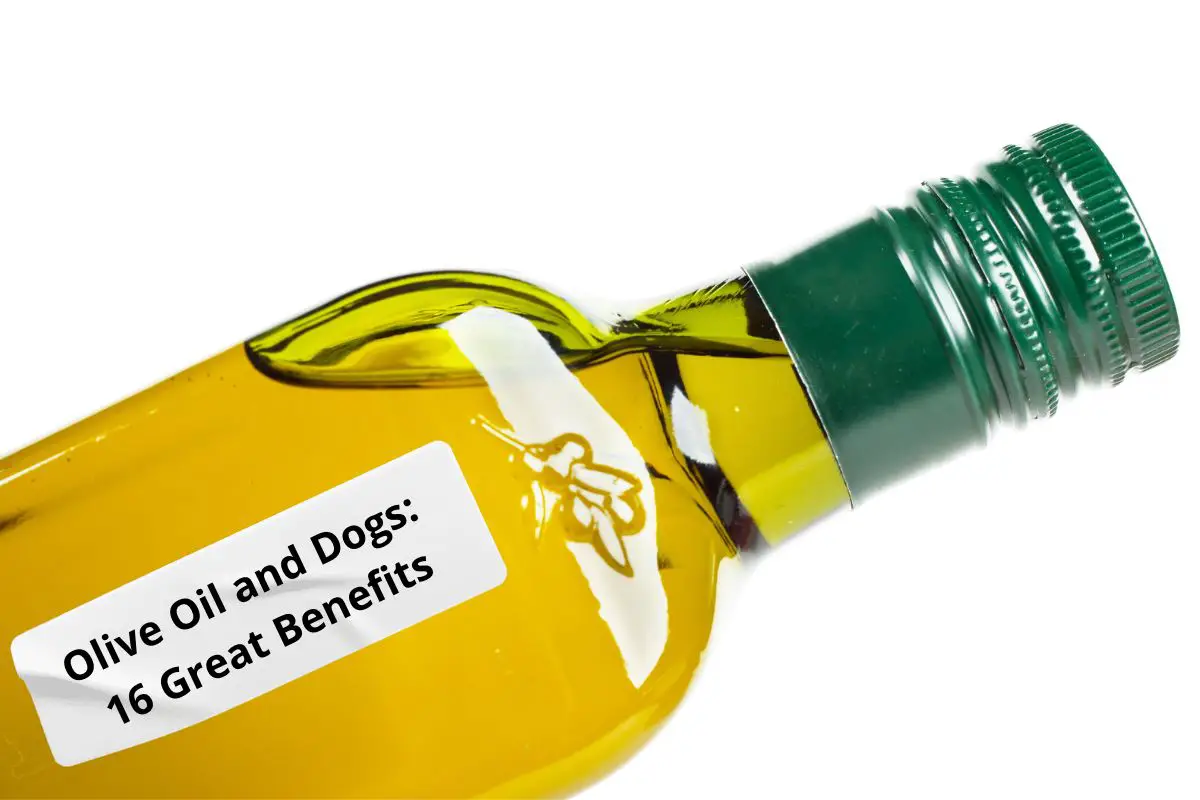This post contains affiliate links.
Dogs are carnivores and therefore need a lot of quality protein in their diet, so their guardians don’t think twice about feeding them meat, including pork. However, pork has health benefits and risks different from other types of meat. Are dogs safe if they eat raw pork?
Dogs can eat raw pork, earning praise from the raw diet movement that claims local pork is safe due to stringent laws and that dogs need raw pork for a balanced diet. However, raw pork nay-sayers claim that the meat could trigger allergies and contain parasites that cause diseases.
This article discusses these two sides’ contrasting reasoning for serving and not serving raw pork to dogs. To balance out their opinions, we’ll make one final suggestion: if you intend to feed your dog raw pork, take proper precautions. Now, let’s talk about the raw pork debate.
Table of Contents
Benefits of Raw Pork for Dogs
Many veterinarians say pork isn’t suitable for dogs, but pet parents can occasionally feed it to their pooches plain, cooked, unseasoned, and deboned.
According to Petmoo, pork contains vitamin B12, about 81% protein, iron, zinc, phosphorus, selenium, niacin, and vitamin C. The rest is fat. The first two ingredients are essential for muscle maintenance and other vital biological functions.
Raw diet advocates add that raw meat is high in potassium and low in sodium, making it suitable for dogs with cardiac problems. Pork has the highest potassium levels among the meat types, has the second-lowest sodium levels after beef, and contains more zinc than chicken.
The Labrador Site claims that pork matches the preferred level of protein, carbohydrates, and other nutrients in a dog’s diet. But it should be served cooked in moderate quantities and ONLY as an addition to an existing conventional wholesome diet.
How Nutrients in Pork Interact With Dog Diets
Vitamin C
Since dogs produce vitamin C naturally in their bodies, they don’t technically need it in their diets. However, research indicates that it benefits chronically ill dogs with lower vitamin C levels because they metabolize more of it than healthy dogs do.
So, they benefit from more vitamin C in their diet.
Vitamin B12
Pork also contains vitamin B12, which bolsters the function of three enzyme types. The malfunctioning of these enzymes increases the chances of developing hyperhomocysteinemia,
a medical condition caused by excessive homocysteine in the blood.
This amino acid is vital in metabolism, but too much of it can lead to cardiovascular disease.
Comparison of Dietary Statistics
Dogs, as carnivores, get most of their energy and nutrients from meat. Their dietary preference is similar to wolves. The Labrador Site says one study found that wolves have a nutrient partiality for a diet with a ratio of 54% protein to 45% fat to 1% carbohydrates. A different analysis revealed that dogs’ dietary ratio is 30% protein, 63% fat, and 7% carbohydrates.
Nevertheless, the two surveys show that both subspecies of Canis lupus eat minimal carbohydrates and focus mainly on protein and fat.
Pork matches this dietary preference in that it primarily contains protein and an “acceptable” amount of fat in it—that dogs and wolves prefer but don’t necessarily satisfy canine nutritionists.
Disadvantages of Pork for Dogs
Compared to chicken or beef, pork is high in fat, which is hard for dogs to digest. A pork-rich diet can cause fat to build up, leading to inflammation, digestive problems, and pancreatitis (inflammation of the pancreas, a gland behind the stomach).
That’s why pork shouldn’t be the primary protein source of dogs. Leaner proteins are a better bet.
Disadvantages of Raw Pork
If a pork product is raw or undercooked, it’s dangerous for both humans and canines. That’s because it may cause allergies, or worse: harbor contagious disease-causing parasites, viruses, and bacteria, such as:
- Trichinella spiralis larvae
- Suid herpesvirus 1
- E. coli (Escherichia coli)
- Salmonella
- MRSA – (multi-drug-resistant staphylococcus aureus) bacteria resistant to antibiotics
Veterinarian Marge Chandler, a small animal internal medicine specialist, explains that dogs’ digestive tracts are much shorter than humans’. But this doesn’t make them immune to bacterial infections. Also, unlike cats, they can’t distinguish between bad and good meat.
What Is Trichinosis?
Trichinosis (trichinellosis) is a disease brought on by trichinella, parasitic roundworms in meat-eating animals. Trichinella enters the body through the gastrointestinal system then invades the muscles. Humans and dogs can get the disease if they eat raw or undercooked meat from infected animals, like pigs.
Once infected, symptoms include gas, vomiting, diarrhea, upset stomach, fever, muscle soreness, pain, upper eyelid swelling, lethargy, pain, and stiffness. Dogs with weak immune systems are more likely to get infected and develop severe symptoms.
The Centers for Disease Control and Prevention report that around 10,000 annual trichinosis cases are diagnosed worldwide. But the disease is rare in the USA due to strict meat processing and animal feed rules. There were only 16 cases yearly from 2011 to 2015, mostly in rural areas. The European Union requires routine testing for it.
Regardless, trichinosis is the chief reason why dogs shouldn’t eat raw or undercooked pork. Although not life-threatening, it does require immediate treatment.
Pork and Dog Allergies
Certain meat types are more likely to cause allergic reactions, including rabbit, lamb, and pork. Research reveals that half of the local dog population are allergic to pork and that dogs have a higher chance of being allergic to pork than other kinds of meat, like chicken, turkey, and beef.
If your dog exhibits allergic symptoms after consuming pork for the first time, stop feeding it pork. The meat may be causing indigestion and inflammation apart from allergies.
Why You Shouldn’t Feed Dogs Raw Pork
Although dogs are carnivores, their domestication has altered their ancient habits to adapt to living with humans for thousands of years. Their bodies’ reaction to raw meat, including pork, is part of that adjustment. That’s why, despite their ability to eat raw meat, their digestive systems don’t work the same way as their ancestors.
Why Raw Food Diet Advocates Approve of Raw Pork
Many zoologists believe dogs are descendants of wolves. Both subspecies’ digestive systems are naturally designed to absorb nutrients from raw meat. That’s why they have a biological need for raw meat and bones for their diets.
Some European canine experts claim it’s wrong to suppress this instinct and stop dogs from eating a raw diet, including pork rib bones. They classify this diet as Biologically Appropriate Raw Food (BARF), which many veterinarians support. It has become a trend with pet parents preferring natural, nutritious, preservative-free diets for their dogs.
The BARF diet’s objective is to help dogs maintain their ingrained habits as carnivores and stay true to their evolutionary process. Yet, critics believe BARF programs shouldn’t apply to pork.
BARF advocates counter that, unlike supermarket pork, BARF-standard pork has been specifically treated for raw diet consumption through a three-week deep freeze to eradicate parasites.
BARF Benefits
Raw diet proponents claim that feeding dogs raw meat, organs, and bones (including pork) is the best way to keep them strong and healthy. They say that a properly formulated raw meat diet has these benefits:
- It boosts the immune system, making dogs more resistant to diseases. However, no diet is a substitute for annual vaccinations.
- It contributes to more supple skin and softer, glossier coats.
- It helps dogs shed less.
- It minimizes dogs’ typical smelly body odor.
- It promotes healthier teeth by decreasing tooth decay and lowering the incidence of periodontal disease.
- It is useful for weight management, specifically for sedentary dogs.
- It increases energy levels.
- It tones muscles.
- It promotes better nutrient absorption.
Canine raw diets may have multiple benefits, but it takes a lot of time, effort, and money to maintain them. Raw diet critics say dog guardians cannot ensure proper nutrition for their pets with raw meat alone. They claim that some well-meaning ones have unwittingly given their dogs nutritional deficiencies because they weren’t feeding them sufficient varieties of meat.
Wolves and other wild canines have an internal monitoring system that signals them to search for food containing nutritional elements they lack. Unfortunately, domesticated dogs don’t have this mechanism.
When they’re deficient in a specific nutrient, they’ll eat whatever they find to address this deficiency. So before having your dog embark on a raw meat culinary adventure, ask your veterinarian or a canine nutritionist for advice.
Busting Raw Food Myths
The Raw Fed blog publishes rebuttals to raw food myths, including raw meat meant for dogs. One excerpt reports that bacteria can contaminate commercial and homemade kibble dog food normally considered sterile.
This is in response to critics denigrating raw diets, implying that these are bacteria-laden and that dog owners should buy only commercial or homemade dog foods because these are “bacteria-free.”
Raw Fed administrators quote JT LeJeune and DD Hancock as claiming that pet food, whether commercial or homemade, “provides an ideal environment for bacterial proliferation” because it contains meat products not meant to be eaten by humans. These include parts of carcasses declared unfit for consumption, inedible tissues, and complete carcasses of diseased, disabled, dying, or dead animals at slaughter time.
Because of the nature of these products and lenient processing requirements, they may contain high levels of bacterial contamination compared to products endorsed for human consumption.
LeJeune and Hancock are the authors of the article titled, “Public health concerns associated with feeding raw meat diets to dogs,” published in the Journal of the American Veterinary Medical Association in 2001.
Can Dogs Eat Pork Bones?
Pet parents assume that bones are ideal yummy treats for dogs because they love to chew these, but some bones aren’t 100% safe and can be very dangerous to canines.
For example, pork bones dry out when cooked, becoming fragile and brittle. When gnawed on, they can splinter into sharp shards. These can obstruct the esophagus, cause choking, tear the walls of the digestive system, or damage internal organs. Raw bones have a lower chance of fragmenting, but it can still happen.
If your dogs enjoy gnawing on bones, get them high-quality, edible dental bones or antlers from pet stores instead.
What About Pork Rib Bones?
Again, there are two warring sides to this subject. These are their opinions:
Detractors of Pork Rib Bones
Best Friends Animal Society Medical Director Susan Konecny doesn’t recommend giving pork rib bones to dogs. She says raw poultry bones and cooked bones of any kind (including pork bones) should be excluded from dog diets.
Veterinarian Stephanie Liff, the proprietor of Pure Paws Veterinary Care in Clinton Hill, New York, says that even though pork is an acceptable protein source, its bones are dangerous, should be discarded, not used as treats.
Dangers of Feeding Dogs Pork Rib Bones
Both agree that, as with all other pork bones, pork rib bones are dangerous for dogs because they splinter inside dogs’ mouths or stomachs and damage teeth, gums, throats, or internal organs.
Konecny reiterates that they’re also choking hazards and can block intestines, leading to constipation.
Liff adds that even if dogs don’t swallow the bones, ingesting their fatty tissue can cause vomiting and diarrhea, leading to dehydration, protein loss, and other serious gastrointestinal issues. Eating lots of pork rib bones can also lead to pancreatitis, a life-threatening disease arising from high-fat meal consumption.
Supporters of Pork Rib Bones
Other canine experts disagree with Konecny and Liff. They say that some dogs can effectively chew on pork rib bones, but it depends on the breed.
To be able to gnaw on them properly, dogs need to have a specific jaw structure. Brachycephalic (short-skulled) breeds like Bulldogs, Boxers, Shih Tzus, and Pugs do not have it. If your dogs don’t belong to these breeds, they can chew on pork rib bones, preferably raw.
What About Raw Pork Bones?
Pork bones can be chewed easily, but that doesn’t mean pet parents should freely give these to their dogs. Unlike bones from other meat sources, pork bones are more prone to fragmentation and breakage even when raw.
Konecny emphasizes that even though cooked bones are more likely to splinter than raw ones, the latter is also dangerous because they can harbor bacteria.
However, the experts at Dog Carion claim that raw bones are a lot different from cooked ones. They say that when chewed, raw bones aren’t harmful, as long as they aren’t swallowed. Gnawing on them cleans teeth and also counts as a good exercise for mouth muscles. But some vets don’t recommend them because of the splintering issue that may also occur in raw bones.
Related article:
Can Dogs Eat Pork Rib Bones? (Is It Safe?)
How Much Pork Can a Dog Eat?
Before launching new munchies into your pooches’ palates and presenting them as rewards, first ensure that these are safe for them to eat. Giving dogs unfamiliar culinary treats can lead to a surprise visit to the vet, or worse, the animal hospital ER.
Like any other pet food checked out in the first instance, pork should be introduced to dogs one small amount at a time to screen for any reaction. Monitor your dogs after feeding them any food that’s not part of their regular diet, especially pork. Be ready for any barfing, tummy ache, loose motion, sluggishness, other alarming side effects, or strange behavior (like intoxication).
If these symptoms occur and remain over an extended period, bring your dogs to the vet immediately. The same goes if they inadvertently gulp down raw pork or cooked pork products with spices in them.
Pork-related squabbles among canine experts aside, generally, dog guardians can occasionally feed their wards plain, cooked, boneless pork meat in moderate amounts. Canine experts recommend feeding pork to dogs, whether raw or cooked, not more than once or twice a month.
Compromise
If you’re adamant about feeding raw pork to your dogs, choose meat processed to BARF standards. Avoid buying cheap pork products because their prices may have been marked down due to expiration dates.
Significantly slashed down rates may also signal meat of questionable quality or source, although there are exceptions. Only buy from reputable butchers, supermarkets, and grocery stores.
Fresh Diet
A fresh diet is a safer alternative to give dogs healthier nutrition. Ollie represents an example. It’s a fresh dog food delivery service that cooks food at a temperature high enough to kill parasites but low enough to retain the nutrients. Then they freeze the preservative-free food and mail it in recyclable packaging with dry ice to dog owner clients at their preferred frequency.
No Seasonings, Please!
Advocates for feeding only cooked pork to dogs emphasize that the meat must be served plain with absolutely no seasonings.
According to the American Kennel Club, most of the ingredients humans use to spice up pork dishes are toxic to dogs because they may cause medical conditions like anemia.
These condiments include:
- Excessive salt
- Garlic
- Onion
- Ground cinnamon
- Ground sage
- Dill seeds
- Mint flakes
- Mustard
- Nutmeg
- Chili powder
- BBQ sauce
No Processed Pork, Either
The World Health Organization revealed in its 2015 report that preservatives in processed meats like preserved pork (including bacon, pepperoni, and ham) might cause cancer. Preserved pork is also rich in salt and fat, which harm the digestive system and cause dehydration, pancreatitis, intestinal twisting, and bloat (food, fluid, or gas retention in the stomach).
Safe Pork Alternatives for Dogs
If you wish to keep your dog’s diet pork-free but still want the benefits that pork meat offers canines, simply substitute it with these:
Non-Meat Options
We’ve sourced opinions from three canine care watchdogs: The Labrador Site, My Large Dogs, and Petful 101.
These are their suggestions:
- Cheese
- Yogurt
- Peanut butter
- Eggs
- Fruits, including bananas, coconut, papayas, and core-free apples
- Vegetables, including broccoli, carrots, pumpkins, and green beans
Meat Alternatives
Chicken is an excellent alternative source of protein for dogs. Veterinarians recommend it because it’s rich in essential minerals, vitamins, fats, and amino acids and is easy to digest. Serve it boiled, plain, and unseasoned, especially to dogs with gastrointestinal conditions.
Bone Alternatives
The folks at Can Pets Eat suggest raw beef, chicken, and lamb bones as alternatives to pork bones because dogs can easily chew on them. However, owners have to supervise their dogs to prevent them from swallowing the bones, potentially creating a choking hazard.
Chewy Dental Substitutes for Pork Bones
It’s your responsibility as a pet guardian to put your dogs’ safety first, regardless of how adorable they look when begging for pork bits from human meals. Consider other options to pork that let them safely and enjoyable chew. Monitor your pets while they’re chewing even seemingly safe toys.
Pet MD experts recommend replacing pork bones with fine-quality edible dental bones. They say there’s no reason to put canine health at risk when other excellent chewing alternatives exist.
Liff suggests antlers, bully sticks, or robust rubber toys. Choose a chew toy larger than what your dog would normally gnaw on to prevent your dog from ripping it apart and swallowing the smaller pieces.
The experts at Ultimate Home Life say that cleaning dogs’ teeth with pork bones (especially raw ones) definitely benefits their dental health, but all the risks mentioned above that come with them aren’t worth the trouble.
The primary benefit dogs’ teeth get from pork bones is the friction aspect. As long as their gnashers can get the same kind of action from other sources, why not explore these? Various options are available that don’t involve the risk of choking or intestinal obstruction.
How To Properly Prepare Pork for Dogs
To be fair, we’ll present suggestions from both sides:
The Cooked Pork Endorsers
They recommend always feeding our four-legged friends fully cooked pork sans seasoning, with the extra fat removed. Strip the meat off the bone, then cut it up into bite-sized pieces before serving to avoid the risk of choking.
Their suggested cooking methods are boiling or steaming. Use oil absorbent sheets to mop up the excess grease generated by cooking pork using oil-saturated methods, such as stir-frying.
Portion out the meat in small pieces and a limited amount, especially if this is the first time your pooch will be eating it.
The Raw Pork Patrons
If you’re hesitant about serving raw pork to your pet, check out the BARF website for ideas, recipes, and familiarize yourself with their product lineup.
BARF is a nutritionally balanced, wholesome formula of raw vegetables, fruits, meat, and bones. Their proprietary blend simulates the dietary preference of your dogs’ ancestors and canines with the ability to thrive in the wild.
Raw diet supporters claim dogs fed with the BARF diet are active, energetic, and free from allergies and medical issues.
Busy pet parents lacking time to prepare regular raw food meals can check out Ollie’s delivery service mentioned above.
Conclusion
Prepared properly, raw pork offers superb benefits for dogs. But pet parents have to do their due diligence to minimize risks and maximize benefits for their pets’ health.
Those who want to play safe can feed dogs pork in moderation. They should also observe two crucial conditions: freeze it for three weeks to kill parasites, then serve it unseasoned, cooked, deboned, and pre-cut.
The raw pork debate has confused pet parents. Ultimately, though, it’s up to them to decide what’s best for their dogs. We hope that by presenting both sides, we have helped clarify their reasoning.
- AVMA Journals: Public health concerns associated with feeding raw meat diets to dogs
- Dissecting Behavior: Are dogs and wolves the same species?
- Nature: Genome sequence, comparative analysis, and haplotype structure of the domestic dog
- American Kennel Club: Can Dogs Eat Pork?
- That Mutt: Can Dogs Eat Raw Pork?
- PubMed.gov: Trichinosis in a dog
- Healthline: Trichinosis
- MSD Veterinary Manual: Trichinellosis (Trichinosis) in Dogs
- Science Direct: Suid herpesvirus 1
- Centers for Disease Control and Prevention: E. coli
- K9joy: The Salmonella Myth
- PetMD: Can Dogs Eat Pork or Rib Bones?
- This Is Dog: Can Dogs Eat Bones?
- Dog Carion: Can Dogs Eat Pork? Raw or Cooked
- Smart Dog Owners: How Safe is Raw Pork and Bones for Your Dog?
- The Labrador Site: Can Dogs Eat Pork? A Guide to Pork and Pork Bones or Ribs for Dogs
- Petful 101: Can Dogs Eat Pork?
- Petful 101: 10 healthy food options for dogs
- The Spruce Pets: Can Dogs Eat Pork?
- My Large Dogs: Can Dogs Eat Raw Pork?
- Can Pets Eat: Can Dogs Eat Pork Raw?
- Dog Pack: Can dogs eat pork? Find out if pork, bacon, and ribs are safe for dogs
- Cuteness: Can Dogs Eat Pork?
- Puppy Foodie: Can dogs eat pork? Risks and health benefits
- What Can Dogs Eat?: Can Dogs Eat Pork?
- Puppy FAQs: Can Dogs Eat Pork?
- Doggy Dog Dog: Can Dogs Eat Pork? Is Pork Bad for My Dog?
- Pet Lab House: Can Dogs Eat Pork?
- Furry Tips: Can Dogs Eat Pork Rib Bones?
- The Dog People: Can My Dog Eat Raw Pork?
- Oodle Life: Why Can’t Dogs Eat Pork? (Safety Guide)
- Ultimate Home Life: Pork and Pork Bones for Dogs
- Petmoo: Can Dogs Eat Pork? What Happens If My Dog Eats Pork?
- Bark How: Can Dogs Eat Pork?
- Raw Fed: Myths About Raw Feeding
- Raw Fed: Feeding dogs a raw diet
- Raw Fed: Myth – My dog will acquire parasites from the raw meat in a raw diet
- Raw Fed: Myth – There is no scientific research to back raw diets
Mrdogfood.com is a participant in the Amazon Services LLC Associates Program, an affiliate advertising program designed to provide a means for sites to earn advertising fees by advertising and linking to Amazon.com. We also participate in other affiliate programs which compensate us for referring traffic.




